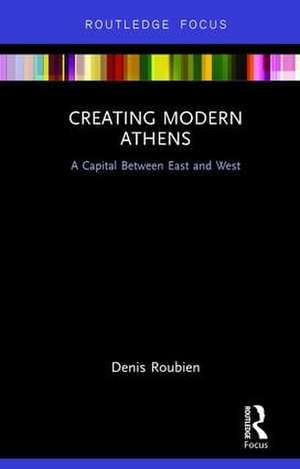Creating Modern Athens: A Capital Between East and West: Routledge Focus on Urban Studies
Autor Denis Roubienen Limba Engleză Hardback – 2 mai 2017
This book explores the development of the city of Athens after the beginning of Greek independence in 1830. It presents the process of creation of a neo-classical capital, in the place of a pre-existing town with the remains of a long history. An array of chapters examine the treatment of the pre-revolutionary town; its connection with the neo-classical city; the position of old churches in this antiquity-centred capital; and the factors that influenced the implementation of the projects for the new capital and their consequences for the city’s evolution. All this will be placed in its European context, explaining how the construction of modern Athens relates heavily to the influence of the ‘great’ European capitals.
This is valuable reading for students and researchers interested in urban design, urban geography, and modern Greek history.
| Toate formatele și edițiile | Preț | Express |
|---|---|---|
| Paperback (1) | 190.77 lei 6-8 săpt. | |
| Taylor & Francis – 30 sep 2020 | 190.77 lei 6-8 săpt. | |
| Hardback (1) | 456.13 lei 6-8 săpt. | |
| Taylor & Francis – 2 mai 2017 | 456.13 lei 6-8 săpt. |
Preț: 456.13 lei
Preț vechi: 536.62 lei
-15% Nou
Puncte Express: 684
Preț estimativ în valută:
87.29€ • 90.80$ • 72.06£
87.29€ • 90.80$ • 72.06£
Carte tipărită la comandă
Livrare economică 14-28 aprilie
Preluare comenzi: 021 569.72.76
Specificații
ISBN-13: 9781138291669
ISBN-10: 1138291668
Pagini: 148
Ilustrații: 13 Line drawings, black and white; 27 Halftones, black and white; 40 Illustrations, black and white
Dimensiuni: 138 x 216 x 10 mm
Greutate: 0.32 kg
Ediția:1
Editura: Taylor & Francis
Colecția Routledge
Seria Routledge Focus on Urban Studies
Locul publicării:Oxford, United Kingdom
ISBN-10: 1138291668
Pagini: 148
Ilustrații: 13 Line drawings, black and white; 27 Halftones, black and white; 40 Illustrations, black and white
Dimensiuni: 138 x 216 x 10 mm
Greutate: 0.32 kg
Ediția:1
Editura: Taylor & Francis
Colecția Routledge
Seria Routledge Focus on Urban Studies
Locul publicării:Oxford, United Kingdom
Public țintă
Postgraduate and UndergraduateCuprins
Introduction Part I: Ideology: the revival of ancient glory 1. The ideological background of the creation of neo-classical Athens: the different priorities between idealism and rationalism in establishing a European capital, and the importance of cultural institutions 2. The relationship of the neo-classical city with the antiquities Part II: The treatment of the pre-revolutionary town 3. The connection of the new neo-classical city with the old one: the treatment of Byzantine and post-Byzantine churches and pre-revolutionary houses 4. Housing a European capital in a small Ottoman town: the use of the pre-revolutionary buildings of Athens for housing the official functions of the new capital Part III: Creation of the new city: the actual circumstances 5. The role of land availability 6. Functionalism in the creation of the new city 7. The role of official functions in the evolution of the city of Athens 8. Public space and monumental architecture: from the grandiose plans of a European metropolis to a peripheral capital between East and West
Notă biografică
Denis Roubien is Assistant Professor at the Department of Civil Engineering in the Technological Educational Institute of Western Greece. His research field is the architecture and urban planning of the nineteenth and the early twentieth century in Greece, as well as the restoration of historical buildings and revival of historical centres. He has written several articles and a chapter in a book on these subjects.
Descriere
This book explores the development of the city of Athens after the Greek War of Independence. It presents the process of creation of a neo-classical capital, in the place of a pre-existing town with the remains of a long history. The book examines the treatment of the pre-revolutionary town, its connection with the neo-classical city, the position of old churches in this antiquity-centered capital, and the factors that influenced the implementation of the projects for the new capital and their consequences on the city’s evolution. It will be of interest to historians, geographers, architects and scholars of Europe.


